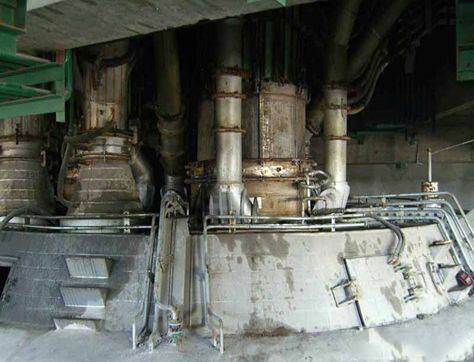Lime and carbonaceous materials in the calcium carbide furnace react to produce calcium carbide, the temperature is as high as 2000~2200, and the calcium carbide liquid is produced every 30~60min. Therefore, the calcium carbide furnace refractory’s high temperature and thermal shock resistance are very high.
The furnace bottom temperature of the calcium carbide furnace is an important parameter reflecting the temperature in the furnace. Low furnace temperature affects calcium carbide production, and high furnace temperature improves output and quality. According to the situation of the general northwest calcium carbide furnace as an example, the experience of refractory materials is summarized:
1. Furnace bottom leveling Pound, a part of the high-alumina castable at the bottom of the furnace, and level it with a 2m level to keep the flatness. The error is less than 3mm
2. Lay G2 brick clay bricks on the high-alumina castables, pave the bedding with high-alumina fire mud, and level it with a 2m level ruler to maintain a flatness of 2mm, and the error is not less than 2mm.
3. Lay G2 high-alumina bricks (LZ-75) on clay bricks and use phosphate fireclay for parallel masonry. It is required that the joints are full of mud, all vertical joints are less than 2mm, and the flatness error is less than 2mm. The upper and lower layers of masonry Center line angle control 15-300
4. To reduce the temperature of the brick lining in the middle of the furnace bottom and improve the stability of the high-alumina brick masonry at the furnace bottom, a layer of new high-temperature insulation material is laid flat on the high-alumina bricks at the furnace bottom. Previously, 400*400*600mm light carbon bricks were used. Now a lot of 1200*1200*1200 mm is used.
Because of the low thermal conductivity and minor porosity of lightweight carbon bricks, they can have the effect of heat resistance and preservation and, at the same time, has strong corrosion resistance. Build two microporous carbon bricks on the light carbon bricks, use anhydrous carbon mortar, keep the vertical joints under 1mm, and use a grinder to smooth the masonry surface. Use a 2m level ruler to detect the flatness error is less than 2mm. the
5. A layer of 10mm thick asbestos board is built on the surface of the side wall of the furnace shell and tightened with a mallet to keep it in close contact with the furnace shell. the
6. The high alumina bricks on the furnace wall are built with phosphate mud, and the joints are full of mud. The joints are less than 2mm, and the gap between the masonry and the asbestos board is mud-filled. A layer of lightweight insulation bricks is built between the asbestos board and the high-alumina bricks to play the role of heat preservation.
7. Furnace mouth adopts corundum composite brick or silicon nitride bonded silicon carbide brick.
In short, selecting refractory materials for a calcium carbide furnace is the best choice to ensure average production and use.


